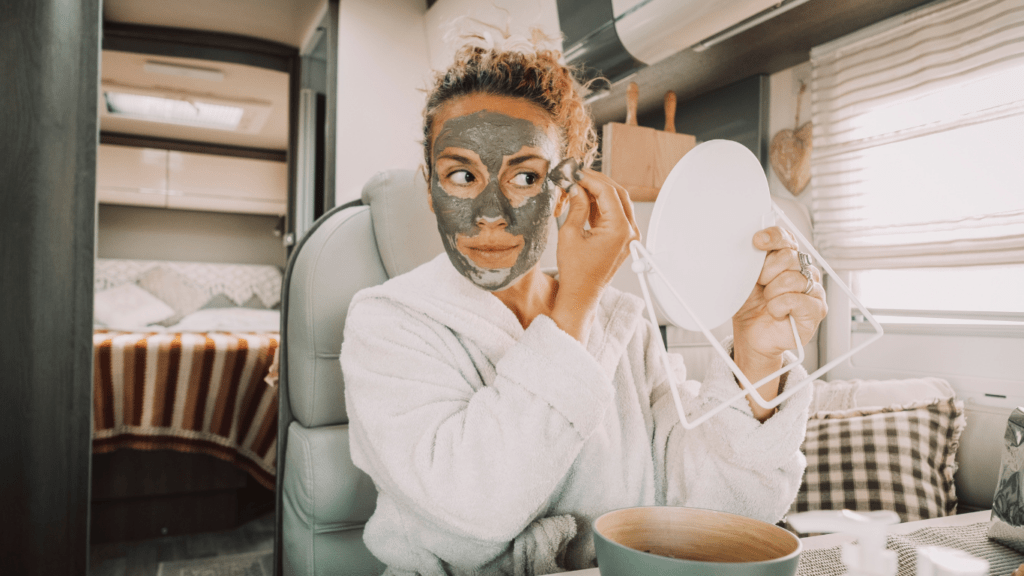Understanding Your Skin Type
Knowing your skin type is crucial for selecting the right DIY face mask. Identifying whether your skin is oily, dry, combination, or sensitive ensures a perfect match for your skincare needs.
Identifying Oily Skin
Oily skin looks shiny and feels greasy, especially in the T-zone (forehead, nose, and chin). Enlarged pores and frequent breakouts also indicate oily skin. Skincare products formulated to control excess sebum are ideal.
Recognizing Dry Skin
Dry skin feels tight and rough, with visible flaking. You might notice redness and fine lines. It often lacks elasticity. Moisturizing ingredients like hyaluronic acid and aloe vera help hydrate and nourish.
Combination Skin Characteristics
Combination skin shows both oily and dry areas. Typically, the T-zone is oily, while cheeks are dry or normal. Balanced skincare routines target both moisture and oil control to maintain skin harmony.
Sensitive Skin Signs
Sensitive skin reacts easily to products, causing redness, itching, or burning. It often appears thin or red. Identifying triggers and using gentle, hypoallergenic products can soothe sensitive skin effectively.
Understanding your skin type helps in tailoring DIY face masks that cater to your unique skincare requirements.
Benefits Of DIY Face Masks
DIY face masks offer numerous advantages for maintaining healthy, radiant skin. Their cost-effectiveness, natural ingredients, and customization options make them a popular choice for skincare enthusiasts.
Cost-Effective Solutions
Homemade masks save money compared to commercial products. Ingredients like:
- yogurt
- honey
- oatmeal
cost a fraction of store-bought masks. For instance, a tub of yogurt can provide multiple applications at a low cost. These solutions make effective skincare accessible to everyone.
Natural Ingredients
DIY masks use natural ingredients, avoiding harsh chemicals. Aloe vera, green tea, and turmeric offer skin benefits without synthetic additives. For example, aloe vera soothes and moisturizes sensitive skin. This approach ensures a gentle yet effective skincare routine.
Customization for Your Needs
Homemade masks can be tailored to your skin type and concerns. Individuals with oily skin can use clay and tea tree oil to reduce shine and acne. In contrast, dry skin benefits from avocado and honey for extra hydration. Customization maximizes the mask’s effectiveness for your specific needs.
DIY Face Mask Recipes For Oily Skin
DIY face masks are excellent for managing oily skin. They help control excess oil, prevent breakouts, and keep the skin looking fresh.
Clay Masks
Clay masks, especially those using bentonite or kaolin clay, work wonders for oily skin. Bentonite absorbs excess oil and unclogs pores. Mix one tablespoon of bentonite clay with one tablespoon of apple cider vinegar to form a paste. Apply this mask for 10-15 minutes, then rinse with lukewarm water. Kaolin clay offers a gentler alternative, particularly for sensitive and oily skin. Create a mask with one tablespoon of kaolin clay and enough water to form a smooth paste. Leave it on for 10 minutes before rinsing.
Charcoal Masks
Charcoal masks effectively remove impurities and excess oil from the skin. Activated charcoal excels at binding to dirt and oil on the surface. Blend one tablespoon of activated charcoal with one tablespoon of aloe vera gel to soothe any potential irritation. Apply this mixture to your face, and rinse off after 10-15 minutes. Adding a few drops of tea tree oil, known for its antibacterial properties, can enhance the mask’s effectiveness.
Honey and Lemon Masks
Honey and lemon masks combine the antibacterial properties of honey with the astringent qualities of lemon. Honey is naturally moisturizing and helps to balance oil production. Mix one tablespoon of raw honey with a teaspoon of fresh lemon juice. Apply this mixture, avoiding the eye area due to the lemon’s acidity. Let it sit for 15 minutes, then rinse off with lukewarm water. This mask is particularly useful for brightening the skin while keeping oiliness in check.
DIY Face Mask Recipes For Dry Skin
Dry skin requires extra moisture and nourishment. Here are some effective DIY face mask recipes specifically designed to hydrate and rejuvenate dry skin.
Avocado Masks
Avocado masks provide essential fatty acids and vitamins for deep hydration. To make an avocado mask, mash half an avocado until smooth. Add one tablespoon of honey and mix well. Apply this mixture evenly across your face and leave it on for 15-20 minutes. Rinse with lukewarm water. Avocados contain vitamins E and C, which promote healthy skin, while honey acts as a natural humectant, retaining moisture.
Banana and Honey Masks
Bananas combined with honey offer both moisture and gentle exfoliation. Mash one ripe banana until smooth. Add one tablespoon of honey and a few drops of almond oil. Mix thoroughly and apply the mask to your face. Let it sit for 15-20 minutes before rinsing off with warm water. Bananas contain potassium and vitamins E and C, which help hydrate and smooth the skin. Honey, with its antibacterial and moisturizing properties, further enhances skin hydration.
Oatmeal and Yogurt Masks
Oatmeal and yogurt masks soothe and nourish dry skin effectively. Mix one tablespoon of finely ground oatmeal with two tablespoons of plain yogurt. Add a teaspoon of honey for extra moisture. Spread the mixture evenly over your face and leave it on for 15-20 minutes. Rinse off gently with warm water. Oatmeal acts as a natural exfoliant and moisturizer, while yogurt contains lactic acid that helps exfoliate and hydrate the skin.
DIY Face Mask Recipes For Combination Skin

Combination skin needs masks that balance oil and hydrate dry areas. Here are versatile DIY recipes suited for this skin type.
Aloe Vera and Cucumber Masks
Aloe vera and cucumber soothe combination skin. Aloe vera hydrates dry areas, while cucumber calms and balances oil.
- Ingredients: 2 tablespoons aloe vera gel, 1/2 cucumber
- Instructions: Blend the cucumber into a puree. Mix with aloe vera gel. Apply the mask evenly, avoiding the eye area. Leave on for 15 minutes and rinse with lukewarm water.
Milk and Honey Masks
Milk and honey masks nourish and balance combination skin. Milk contains lactic acid for gentle exfoliation, while honey offers moisture.
- Ingredients: 2 tablespoons milk, 1 tablespoon honey
- Instructions: Mix milk and honey until well combined. Apply the mixture to your face and neck. Let it sit for 20 minutes, then wash off with warm water.
Green Tea Masks
Green tea masks refresh and tone combination skin. Green tea provides antioxidants and helps control oil.
- Ingredients: 1 green tea bag, 2 tablespoons honey
- Instructions: Steep the green tea bag in hot water for 5 minutes, then let it cool. Mix the cooled tea with honey. Apply to your face, wait for 15 minutes, and rinse off with cool water.
DIY Face Mask Recipes For Sensitive Skin
Sensitive skin requires gentle and soothing treatments to avoid irritation. I’ll share some calming DIY face mask recipes below.
Chamomile Masks
Chamomile has anti-inflammatory properties that calm sensitive skin. To create a chamomile mask, steep 1-2 chamomile tea bags in half a cup of hot water for 10 minutes. Let it cool, then mix the tea with two tablespoons of oatmeal and one teaspoon of honey. Apply to your face and leave it on for 15-20 minutes before rinsing with cool water. This mask reduces redness and soothes irritation.
Cucumber and Yogurt Masks
Cucumber and yogurt masks hydrate and cool sensitive skin. Blend half a cucumber until smooth, then mix it with two tablespoons of plain yogurt. Apply the mixture to your face and leave it on for 15 minutes. Rinse with lukewarm water for a refreshing effect. Cucumber calms, and yogurt adds moisture and gentle exfoliation.
Aloe Vera and Honey Masks
Aloe vera and honey provide soothing and moisturizing benefits. Mix one tablespoon of pure aloe vera gel with one tablespoon of honey. Spread the mixture on your face and leave it on for 20 minutes. Rinse with cool water. Aloe vera’s anti-inflammatory properties combined with honey’s antibacterial effects make this mask ideal for sensitive skin.
Tips For Applying DIY Face Masks
Applying DIY face masks correctly ensures maximum benefit for every skin type. Follow these essential tips to enhance your skincare routine.
Preparing Your Skin
Start with a clean face. Use a gentle cleanser suited to your skin type to remove dirt, oil, and makeup. Exfoliate lightly before the mask, using a mild scrub or a washcloth to remove dead skin cells and open pores. Pat your face dry with a soft towel before applying the mask.
Application Techniques
Use clean hands or a brush to apply the mask evenly. Start from your forehead, move to your cheeks, then cover your nose and chin. Spread the mask in an upward motion to avoid tugging on your skin. Avoid the eye and lip areas, which are more sensitive and prone to irritation. Apply a slightly thicker layer to areas needing more attention, like the T-zone for oily or combination skin.
Post-Mask Care
Rinse off the mask with lukewarm water, using gentle circular motions. Pat your skin dry with a clean towel. Follow up with a toner to balance your skin’s pH and tighten pores. Finish with a moisturizer that matches your skin type to lock in hydration. Apply sunscreen if you’re heading out, as your skin may be more sensitive to sunlight after the treatment.



